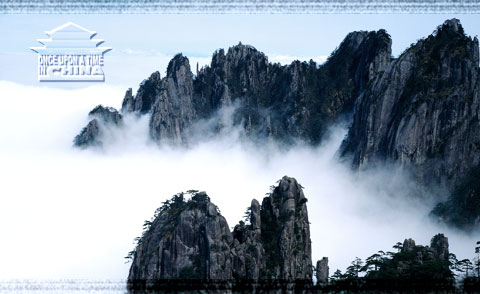
Mount Huang, also known as Huangshan (Chinese: 黄山; pinyin: Huángshān; literally "Yellow Mountain"), is a mountain range in southern Anhui province in eastern China. The area is well known for its scenery, sunsets, peculiarly-shaped granite peaks, Huangshan Pine trees, and views of the clouds from above. Mount Huang is a frequent subject of traditional Chinese paintings and literature, as well as modern photography. Today, it is a UNESCO World Heritage Site and one of China's major tourist destinations.
Physical features for which Mount Huang is known include sunrises, pine trees, "strangely jutting granite peaks", and views of clouds touching the mountainsides on more than 200 days out of the year.
The Huangshan mountain range comprises many peaks, some more than 1,000 meters (3,250 feet) high. The three tallest and best-known peaks are Lotus Peak (Lian Hua Feng, 1,864 m), Bright Summit Peak (Guang Ming Ding, 1,840 m), and Celestial Peak (Tian Du Feng, literally Capital of Heaven Peak, 1,829 m). The World Heritage Site covers a core area of 154 square kilometres and a buffer zone of 142 square kilometres. The mountains were formed in the Mesozoic, about 100 million years ago, when an ancient sea disappeared due to uplift. Later, in the Quaternary Period, the landscape was shaped by the influence of glaciers.
The well-known Ying Ke Pine, or Welcome PineThe vegetation of the area varies with altitude: Below 1,100 meters, moist forest can be found; deciduous forest stretches from 1,100 meters up to the tree line at 1,800 meters; above that point, the vegetation consists of alpine grass-lands. The area has diverse flora, where one-third of China's bryophyte families and more than half of its fern families are represented. The Huangshan pine (Pinus hwangshanensis) is named after Mount Huang and is seen as an example of vigor because the tree does not take root in soil, but in rocks. Many of the area's pine trees are more than a hundred years old and have been given their own names (such as the Ying Ke Pine, or Welcoming-Guests Pine, which is thought to be over 1500 years old). The pines vary greatly in shape and size, with the most crooked of the trees being considered the most attractive. Furthermore, Mount Huang's moist climate facilitates the growing of tea leaves, and the mountain has been called "one of China's premier green tea-growing mountains. Mao feng cha ("Fur Peak Tea"), a well-known local variety of green tea, takes its name from the downy tips of tea leaves found in the Mount Huang area.
The mountaintops often offer views of the clouds from above, known as the Sea of Clouds (simplified Chinese: 云海; pinyin: yúnhǎi) or "Huangshan Sea" because of the clouds' resemblance to an ocean, and many vistas are known by names such as "North Sea" or "South Sea." One writer remarked on the view of the clouds from Huangshan as follows:
To enjoy the magnificence of a mountain, you have to look upwards in most cases. To enjoy Mount Huangshan, however, you've got to look downward. The area is also host to notable light effects, such as the renowned sunrises; watching the sunrise is considered a "mandatory" part of visiting the area. A phenomenon known as Buddha's Light (simplified Chinese: 佛光; pinyin: fóguāng) is also well-known; on average, Buddha's Light only appears a couple times per month. In addition, Mount Huang has multiple hot springs, most of them located at the foot of the Purple Cloud Peak. The water stays at 42 °C all year and has a high concentration of carbonates, and is said to help prevent skin, joint, and nerve illness. Mount Huang is a common tourist destination in China, with at least 140 sections open to visitors. The foot of the mountains is linked by rail and by air to Shanghai, and is also accessible from cities such as Hangzhou and Wuhu. As of 1990, there were over 50 kilometers of footpaths providing access to scenic areas for visitors and staffers of the facilities; today there are also cable cars that tourists can use to ride directly from the base to one of the summits. Throughout the area there are hotels and guest houses that accommodate overnight visitors, many of whom hike up the mountains, spend the night at one of the peaks to view the sunrise, and then descend by a different route the next day.
The hotels, restaurants, and other facilities at the top of the mountain are serviced and kept stocked by porters who carry resources up the mountain on foot, hanging their cargo from long poles balanced over their shoulders or backs.









0 comments:
Post a Comment